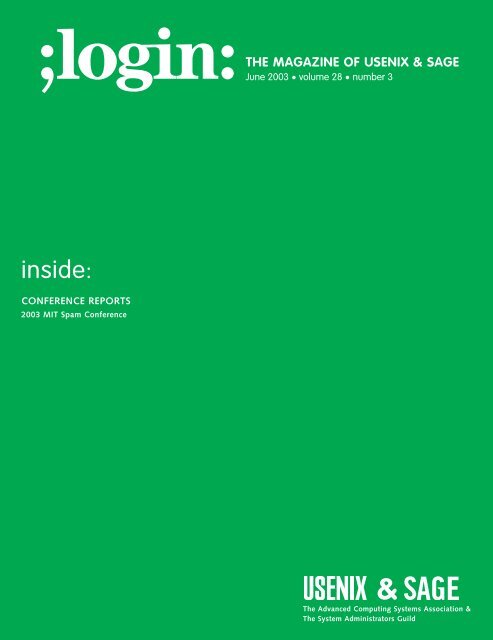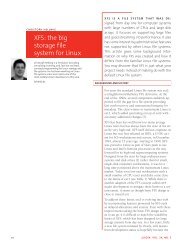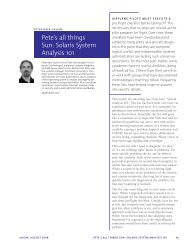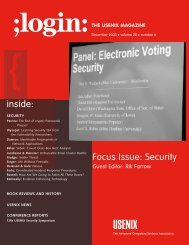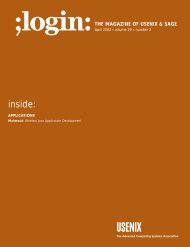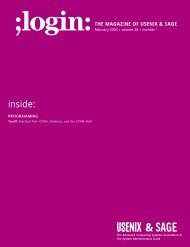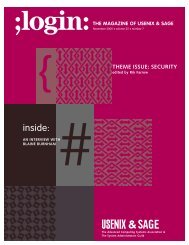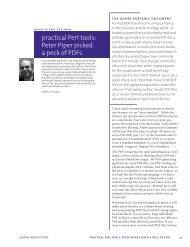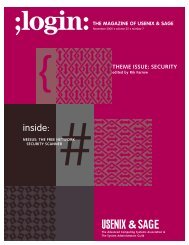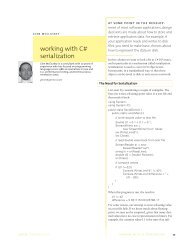Create successful ePaper yourself
Turn your PDF publications into a flip-book with our unique Google optimized e-Paper software.
THE MAGAZINE OF <strong>USENIX</strong> & SAGE<br />
June <strong>2003</strong> • volume 28 • number 3<br />
inside:<br />
CONFERENCE REPORTS<br />
<strong>2003</strong> <strong>MIT</strong> <strong>Spam</strong> <strong>Conference</strong><br />
&<br />
The Advanced Computing Systems Association &<br />
The System Administrators Guild
This issue’s reports focus on the <strong>2003</strong><br />
<strong>Spam</strong> <strong>Conference</strong>, USITS ‘03, and FAST<br />
‘03<br />
OUR THANKS TO THE SUMMARIZERS:<br />
FOR SPAM ’03:<br />
Chris Devers<br />
FOR USITS ’03:<br />
Ajay Gulati<br />
Xuxian Jiang<br />
FOR FAST ’03:<br />
Scott Banachowski<br />
Nate Edel<br />
Preethy Vaidyanathan<br />
conference reports<br />
<strong>2003</strong> <strong>MIT</strong> <strong>Spam</strong> <strong>Conference</strong><br />
CAMBRIDGE, MA<br />
JANUARY 17, <strong>2003</strong><br />
http://spamconference.org/<br />
Summarized by Chris Devers<br />
[Editor’s Note: The summaries by Chris<br />
Devers were condensed for publication in<br />
;login:.]<br />
SPARSE BINARY POLYNOMIAL HASHING<br />
AND THE CRM114 DISCRIMINATOR<br />
William S. Yerazunis, Mitsubishi Electric<br />
Research Laboratories<br />
Yerazunis wrote the CRM114 filtering<br />
mini-language and then wrote MailFilter<br />
in CRM114 as an implementation that<br />
can be used with other spam-fighting<br />
programs. The basic idea is to decompose<br />
a message into a set of “features”<br />
composed of various runs of single<br />
words, consecutive words, words<br />
appearing within a certain distance of<br />
one another, etc.<br />
He claimed that with this software he<br />
could get better than 99.9% accuracy in<br />
nailing spam, and a similar percentage<br />
in avoiding “ham” (the term everyone<br />
was using for false positives – legit mail<br />
that was falsely identified as spam). One<br />
of Yerazunis’ observations is that the<br />
best way to defeat the spam problem is<br />
to disrupt the economics: if a 99.9% or<br />
better filter rate were to become the<br />
norm, then the cost of delivering spam<br />
could be pushed higher than the cost of<br />
traditional mail and the problem would<br />
naturally go away without requiring legislation.<br />
THE SPAMMER’S COMPENDIUM<br />
John Graham-Cumming, POPFile<br />
Most of this very entertaining talk was<br />
about the ingenious tricks that spammers<br />
resort to to obfuscate spam against<br />
filters, including, most diabolically, one<br />
example that placed each column of<br />
monospace text in the message into an<br />
HTML column, so that the average<br />
HTML-capable mail client would render<br />
the message properly, but it would be<br />
absolute gibberish to most mail filters.<br />
The ultimate lesson was that any good<br />
filter has to focus not on “ASCII space”<br />
(the literal bytes as transmitted) but the<br />
“eye space” (the rendered text as seen by<br />
the user), which, by extension, may<br />
mean that any full-scale spam parser/filter<br />
could also have to include a full-scale<br />
HTML and JavaScript engine.<br />
As for Graham-Cumming’s software, it’s<br />
a Perl application, available for all platforms<br />
(Windows, Mac, and, of course,<br />
Linux) that enables users to filter POP3<br />
mail. Interesting stuff if you’re a POP<br />
user: http://popfile.sourceforge.net.<br />
SHOPIP<br />
John T. Draper<br />
Most of Draper’s work seemed to be<br />
focused on profiling spammers, as<br />
opposed to profiling spam itself, by<br />
throwing out a series of honeypot<br />
addresses and using data collected to<br />
hunt down spammers.<br />
http://spambayes.sourceforge.net<br />
SPAM RESEARCH: ESTABLISHING A<br />
FOUNDATION AND MOVING FORWARD<br />
Paul Judge, CipherTrust<br />
Judge’s big argument, which no one<br />
really disagrees with, is that spam has<br />
become not just a nuisance but an actual<br />
information security issue. To that end,<br />
he is advocating much more collaborative<br />
effort to address the problem than<br />
we have seen to date: conferences like<br />
this, mailing list discussions, better tools,<br />
and public data repositories of known<br />
spam (and ham). To that last point, one<br />
of his observations (which others made<br />
as well) was that there are no universally<br />
agreed-on standards for what qualifies<br />
as spam, so repositories for spam will<br />
not be accurate for all users (e.g., spam<br />
for your programmers will be the breadand-butter<br />
of your marketing department).<br />
Plus, there are obvious privacy<br />
issues in publishing your spam and ham<br />
● CONFERENCE REPORTS<br />
June <strong>2003</strong> ;login:<br />
<strong>MIT</strong> SPAM CONFERENCE ●<br />
65
for public scrutiny. And to add another<br />
wrinkle, one danger of public spam/ham<br />
databases is that spammers can poison<br />
them with false data, screwing things up<br />
for everyone. That said, he encouraged<br />
users to help out with building<br />
http://spamarchive.org.<br />
BETTER BAYESIAN FILTERING<br />
Paul Graham, Arc Project<br />
Graham is the man who organized the<br />
conference and kicked off everything<br />
this week with his landmark paper from<br />
last fall, “A Plan for <strong>Spam</strong>.” Graham’s<br />
spam-filtering technique famously<br />
makes use of Bayesian statistics, a technique<br />
popular with nearly all of the<br />
speakers. The nice thing about a statistical<br />
approach, as opposed to heuristics,<br />
simple phrase matching, RBLs, etc., is<br />
that Bayesian statistics can be very<br />
robust and accurate; the down sides are<br />
that they have to be trained against a<br />
sufficiently large “corpus” of spam (most<br />
techniques have this property, though)<br />
and they have to be continually retrained<br />
over time (again, this is common).<br />
Graham was too modest to<br />
produce numbers, but subjectively his<br />
results seemed to be even better than<br />
what Yerazunis gets with MailFilter by<br />
an order of magnitude or more.<br />
Like other speakers, he predicted that<br />
spammers are going to make their messages<br />
appear more and more like “normal”<br />
mail, so we’re always going to have<br />
to be persistent about this; as one example,<br />
he showed us an email he received<br />
IN ALL CAPS from a non-Englishspeaker<br />
asking for programming help,<br />
and although it was legit, the filters<br />
insisted otherwise. “That message is the<br />
one that keeps me up at night.”<br />
Everyone interested in the spam issue<br />
should go read Graham’s paper immediately.<br />
INTERNET LEVEL SPAM DETECTION AND<br />
SPAMASSASSIN 2.50<br />
Matt Sergeant, MessageLabs<br />
<strong>Spam</strong>Assassin is a well-known Perl<br />
application for heuristically profiling<br />
messages as spam, adding headers to the<br />
message, saying, for example, “I am 72%<br />
sure this is spam because it has X Y Z,”<br />
and passing off the message to procmail,<br />
or whatever, to be handled accordingly.<br />
SA can handle a message throughput<br />
great enough that it can be deployed at<br />
the network level (whereas some of the<br />
other applications, which might have<br />
somewhat better hit rates, are still too<br />
inefficient at this point). Deployed this<br />
way, the differences in effectiveness for<br />
single vs. multiple users becomes very<br />
apparent, as 99% effective rates fall<br />
down into the 95–80% range. This happens<br />
because, again, different users<br />
define different things as spam, so mapping<br />
one fingerprint to all users can<br />
never work quite right.<br />
For an example of a tool that your company<br />
can deploy right now and get fast,<br />
decent results, SA looks like a good<br />
choice; but for the long run it looks like<br />
a Bayesian technique is going to get better<br />
performance, and SA is adding a statistical<br />
component to its toolkit. Good<br />
talk.<br />
ANTI-SPAM TECHNIQUES AT PYTHON.ORG<br />
Barry Warsaw, Pythonlabs at Zope<br />
Corporation<br />
This was another example of the “monocultures<br />
are dangerous” philosophy, as<br />
Warsaw explained how he is helping to<br />
use a variety of anti-spam techniques –<br />
from clever Exim MTA configuration to<br />
good use of <strong>Spam</strong>Assassin and procmail<br />
to fine-tuning of the Mailman mailing<br />
list engine – to work together to manage<br />
the spam problem for all things Python<br />
(Python.org, Zope, many mailing lists, a<br />
few employees, etc.).<br />
He pointed out that some very simple<br />
filters can be surprisingly effective: run a<br />
sanity check on the message’s date, look<br />
for obviously forged headers, make sure<br />
the recipients are legit, scan for missing<br />
Message-ID headers, etc. In response to<br />
the person who originally posted the<br />
article, yes, he did mention blocking<br />
outgoing SMTP as an effective element<br />
of a many-tiered spam management<br />
approach.<br />
Among other tricks for getting the different<br />
filtering tiers to play nice together,<br />
they make heavy use of the X-Warning<br />
header so that if an alarm goes off in one<br />
tier of their mail architecture, other<br />
components can respond appropriately.<br />
Cited projects included ElSpy and<br />
<strong>Spam</strong>Bayes.<br />
SPAM: THREAT OR MENACE? AN ISP'S VIEW<br />
Barry Shein, The World<br />
His core argument is that spam is “the<br />
rise of organized crime on the Internet,”<br />
that filters are nice but that the mail<br />
architecture itself is fundamentally<br />
flawed, and that ISPs like his – in 1989,<br />
The World was the world’s first dialup<br />
ISP – are being killed by the problem.<br />
Shein was very annoyed that all these<br />
talented people are having to clean up a<br />
mess like this when they should be out<br />
working on more interesting stuff. His<br />
big hope seemed to be that legislation<br />
will someday come to the rescue, but he<br />
sounded very pessimistic. (Others in the<br />
room seemed to feel that this was a very<br />
interesting machine-learning problem<br />
and weren’t really fazed by his pessimism<br />
– but, then, most of the people<br />
in the room don’t run ISPs.)<br />
He also suggested that we need to find a<br />
way to make spammers pay for the<br />
bandwidth they are consuming (rather<br />
than having users and ISPs shoulder the<br />
burden) but didn’t seem to know how<br />
we might go about implementing this.<br />
At all.<br />
SMARTLOOK: AN E-MAIL CLASSIFIER<br />
ASSISTANT FOR OUTLOOK<br />
Jean-David Ruvini, e-lab Bouygues SA<br />
This was an interesting product. Ruvini’s<br />
company is developing an extension to<br />
66 Vol. 28, No. 3 ;login:
Outlook 2000 and XP that will watch the<br />
way users categorize messages into folders,<br />
come up with a profile for what<br />
kinds of messages end up in which folders,<br />
and then try to offer similar categorization<br />
on an automatic basis. Think of<br />
it as procmail for Outlook, without having<br />
to mess with (or even be aware of!)<br />
all the nasty recipes.<br />
Obviously, if you have a spam folder,<br />
then spam will be one of the categories<br />
it looks for, but, more broadly, it will try<br />
to categorize all your mail as you would<br />
ordinarily categorize it. This makes<br />
SmartLook a broader tool than “just” a<br />
spam manager.<br />
SmartLook is another statistical filter,<br />
though it uses non-Bayesian algorithms<br />
to get results. e-labs’ tests suggest that<br />
the product is able to properly categorize<br />
messages about 96% of the time,<br />
with no false positives, and (for their<br />
tests, mind you) that it performed better<br />
than Bayesian filters over three months<br />
of usage.<br />
One nice property of this tool was that it<br />
works well with different (human) languages<br />
– some strategies fall apart<br />
and/or need retraining when you switch<br />
from English to some other language.<br />
For certain markets (e-lab is in France)<br />
this is a crucial feature, and having a tool<br />
that works with one of the biggest mail<br />
clients out there (most people don’t use<br />
Mutt or Pine, sadly enough) can be very<br />
valuable. Very clever – watch for the<br />
inevitable embrace and extend three<br />
years from now.<br />
LESSONS FROM BOGOFILTER<br />
Eric Raymond, Open Source Initiative<br />
He didn’t say anything about guns, but<br />
he did try to correct one of the other<br />
speakers for misusing the term “hacker.”<br />
Like Graham, ESR is a Lisp fan, but he<br />
knows that the vast majority of people<br />
aren’t, and he also knows that the vast<br />
majority of people need to be using<br />
something like Graham’s spam software.<br />
So on a lark, he came up with a clean<br />
version in C, named it bogofilter, and<br />
put it on SourceForge, where a community<br />
sprang up to, well, embrace and<br />
extend it.<br />
As good as Graham’s Bayesian algorithm<br />
is, ESR felt – as did many of the other<br />
speakers – that the nature of your<br />
spam/ham corpus is much more significant<br />
than the relative difference among<br />
any handful of reasonably good algorithms.<br />
(Back to the often-repeated<br />
point about how corpus effectiveness<br />
falls apart when used for a group of<br />
users, as opposed to individuals.)<br />
To that end, he strongly felt that the best<br />
way to deal with the spam problem is to<br />
get good tools into the hands of as many<br />
people as possible, and to make them as<br />
easy to use as possible.<br />
As an example, one of the first things he<br />
did was to patch the Mutt mail agent so<br />
that it had two delete keys: one for general<br />
deletion and one to “get rid of this<br />
because it’s spam.” That second key, and<br />
interface touches like it, seem like the<br />
way to get average people to start using<br />
filters on a regular basis.<br />
SPAM FILTERING: FROM THE LAB TO THE<br />
REAL WORLD<br />
Joshua Goodman, Microsoft Research<br />
Unlike ESR, Goodman felt that algorithm<br />
selection does make a big difference,<br />
but, this being Microsoft, he<br />
refused to disclose what algorithms his<br />
team is working with – except to say<br />
that, when delivered, they will be more<br />
accessible for average users than<br />
<strong>Spam</strong>Assassin, procmail recipes, or<br />
Mutt.<br />
Microsoft has been working on the spam<br />
problem since 1997, but because of how<br />
big they are, they’ve had unique problems<br />
in bringing solutions to market. As<br />
a case in point, they tried to introduce<br />
spam filters in a 1999 Outlook Express<br />
release, but were immediately sued by<br />
email greeting card company Blue<br />
Mountain because their messages were<br />
being inaccurately categorized as spam.<br />
With that in mind, they have been very<br />
reluctant to bring new anti-spam software<br />
out since then, because they would<br />
like to see legislation protecting “good<br />
faith spam prevention efforts.”<br />
As a very large player, Microsoft faced<br />
certain difficulties in developing useful<br />
filters: It may make sense for you as an<br />
individual to filter all mail from Korea,<br />
but this doesn’t work so well if you are<br />
trying to attract customers from Korea.<br />
This has forced them to put a lot of<br />
work into thoroughly testing different<br />
strategies before offering them to the<br />
public.<br />
In spite of what millions of Webmail<br />
users might have expected, Hotmail and<br />
MSN are currently being filtered by<br />
Brightmail’s service, and plans are<br />
underway to re-introduce spam-management<br />
features to client-side software<br />
again. (Just imagine how bad it would<br />
be if they weren’t paying someone to filter<br />
for them!)<br />
An interesting barrier his group has had<br />
to grapple with was what he called the<br />
“Chinese menu” or “madlibs” spam generation<br />
strategy: that it’s easy to come up<br />
with a template for spam – “[a very special<br />
offer] [to make your penis bigger]<br />
[and please your special lady friend all<br />
night!” vs. “[an exclusive deal] [for genital<br />
enlargement] [that will boost your<br />
sex life!]” etc. – and have a small handful<br />
of options for each “bucket” multiplying<br />
into a huge variety of individual messages<br />
that are easy for a human to group<br />
together but almost impossible for software<br />
to identify.<br />
INTEGRATING HEURISTICS WITH N-GRAMS<br />
USING BAYES AND LMMSE<br />
Michael Salib, extremely funny <strong>MIT</strong><br />
student<br />
Unlike nearly all other filter writers of<br />
the day, Salib’s approach was heuristic:<br />
find a handful of reasonable spam discriminators,<br />
throw them all against his<br />
mail, and see how much he can identify<br />
that way. “It’s sketchy, but this is a class<br />
● CONFERENCE REPORTS<br />
June <strong>2003</strong> ;login:<br />
<strong>MIT</strong> SPAM CONFERENCE ●<br />
67
project. I don’t have to be realistic. These<br />
results may be completely wrong.”<br />
Much to his surprise, he’s trapping a lot<br />
of spam. He pulls in a little bit of RBL<br />
data (“the first two or three links from<br />
Google, whatever”), looks for some patterns,<br />
and then churns it through<br />
LMMSE, an electrical engineering technique<br />
that, as far as he can tell, doesn’t<br />
seem to be known in other fields. Basically,<br />
this involves running the messages<br />
through a series of scary-but-fast-to-calculate<br />
linear equations. It turns out that<br />
he can process this much faster than a<br />
Bayesian filter, to the point that customizing<br />
his approach for each user in a<br />
network would actually be feasible.<br />
For a small spam corpus, he got results<br />
better than <strong>Spam</strong>Assassin did, though<br />
for a large corpus his results were worse;<br />
he couldn’t really account for why this<br />
would be the case, or predict how things<br />
would scale as the corpus continued to<br />
grow.<br />
FORTY YEARS OF MACHINE LEARNING FOR<br />
TEXT CLASSIFICATION<br />
David D. Lewis, Independent<br />
Consultant<br />
The core of Lewis’s argument, as ESR<br />
said earlier in the day, is that for any<br />
machine-learning technique, the quality<br />
of the learning corpus is much more<br />
important than the algorithm used.<br />
Bayes is one such algorithm, but there<br />
are many other good ones in the literature.<br />
Lewis pointed out that all of this<br />
has been publicly discussed since the<br />
first machine-learning paper was published<br />
in 1961.<br />
Observations: “Lots of task[-non-specific]<br />
stuff works badly, but task-specific<br />
stuff helps a lot.” It is important to use<br />
different bodies of text for training and<br />
for general use, so that you don’t train<br />
your machine to focus too much on certain<br />
types of input (this is a point that<br />
Microsoft’s Goodman made as well).<br />
As Graham did, Davis emphasized that<br />
spam is going to slowly start looking<br />
more like natural text, and we’re going<br />
to have to deal with this as time goes on.<br />
http://www.daviddlewis.com/events/<br />
HOW LAWSUITS AGAINST SPAMMERS CAN<br />
AID SPAM-FILTERING TECHNOLOGY: A SPAM<br />
LITIGATOR'S VIEW FROM THE FRONT LINES<br />
Jon Praed, Internet Law Group<br />
To a burst of tremendous applause, this<br />
talk began with the sentence, “My name<br />
is Jon Praed, and I sue spammers.”<br />
He brought a legal take on the “not<br />
everything is spam to everybody” angle,<br />
emphasizing that we need a precise definition<br />
of what qualifies as Unsolicited<br />
Commercial Email (UCE). In particular,<br />
it has been difficult trying to pin down<br />
whether the mail was really unsolicited,<br />
as this is where the spammers have the<br />
most wiggle room. However, if you can<br />
track down the spammer, they have, to<br />
date, rarely been able to verify that the<br />
user asked for mail, and so Praed has<br />
been able to successfully prosecute several<br />
spammers using this angle. But he<br />
doesn’t expect this to work forever.<br />
According to Praed, “Laws against spam<br />
exist in every state, and more are pending,”<br />
but he doubts that a legal solution<br />
will ever be completely effective as long<br />
as spam is lucrative. By analogy, he<br />
pointed out that people still rob banks,<br />
and that has never been legal.<br />
Praed informed the audience that there<br />
are several ways to get back at spammers,<br />
including injunctions, bankruptcy,<br />
and contempt, and all of these can be<br />
very effective. He pointed out that, to be<br />
blunt, a lot of these people are desperate<br />
low-lifes, and spam has been their<br />
biggest success in life. After these legal<br />
responses, their lives all get much worse.<br />
It hadn’t occurred to me to see spammers<br />
as pitiful before, but I can now.<br />
Most importantly, Praed stressed that<br />
these legal remedies can be very effective,<br />
and he strongly warned against taking<br />
vigilante action. This is almost<br />
always worse than the spam itself, and it<br />
only serves to get you in even deeper<br />
trouble than the spammer.<br />
Most spam comes from offshore spam<br />
houses, abuse of free mail accounts<br />
(Hotmail and Yahoo, free signups at<br />
ISPs, etc.) and bulk software (which may<br />
apparently soon become illegal in certain<br />
areas, provided that a law can be<br />
found to ban spam software while allowing<br />
tools like Mailman and Majordomo).<br />
Interestingly, he questioned the<br />
idea that IP spoofing is a big problem<br />
and claimed that in every case he has<br />
dealt with he has been able to track<br />
down the messages to a legit source<br />
sooner or later.<br />
Suggestion: If you get a spam citing a<br />
trademarked product (e.g., Viagra), forward<br />
it to the trademark holder and they<br />
will almost always follow up on it. Suggestion:<br />
Be fast in trying to track down<br />
spammers, as some of them have gotten<br />
in the habit of leaving sites up long<br />
enough for mail recipients to visit, but<br />
taking them down before investigators<br />
get a chance to take a look. Legal observation:<br />
<strong>Spam</strong> is almost always fraud, and<br />
can be prosecuted accordingly.<br />
Praed wrapped up his talk by citing the<br />
encouraging precedent that the famous<br />
Verizon Online v. Ralsky case set:<br />
(1) that the court is interested in where<br />
the harm occurs, not where the person<br />
doing harm was when causing it, and<br />
(2) it is assumed that you have to be<br />
familiar with a remote ISP’s acceptable<br />
usage policies, and ignorance is no<br />
defense. (Just as you can’t say, “I didn’t<br />
know it was illegal to shoot someone,”<br />
Ralsky couldn’t say that he didn’t know<br />
Verizon prohibits spam. He had to have<br />
known that the AUP wouldn’t allow<br />
what he was doing, so he deliberately<br />
didn’t read it.)<br />
That precedent makes the idea of future<br />
prosecution of spammers much more<br />
encouraging. While, again, legal solutions<br />
may never eliminate the spam<br />
problem, a precedent like this can be an<br />
68 Vol. 28, No. 3 ;login:
important supplement to filtering<br />
efforts.<br />
DESPERATELY SEEKING: AN ANTI-SPAM<br />
CONSORTIUM<br />
David Berlind, ZDNet executive editor<br />
His talk was primarily about how he<br />
receives a huge quantity of email from<br />
ZDNet readers, and he can’t afford to<br />
use any spam-filtering solution strategy<br />
that would allow any false positives. As<br />
one of the speakers said, getting a 0%<br />
false positive rate is easy: just classify<br />
nothing as spam. Getting a 100% hit rate<br />
is also easy: just classify everything as<br />
spam. Any solution besides those two is<br />
always going to have some degree of<br />
error either way, and determining how<br />
much of what kind of error you want to<br />
accept is up to you.<br />
Most users will tolerate a moderate false<br />
negative rate (some spam gets through)<br />
if it means that the false positive rate<br />
(legit mail is deleted) is very low. In<br />
Berlind’s case, the false positive rate has<br />
to be vanishingly small, because reading<br />
all customer mail is, to him, a critical<br />
sign of respect for his readers.<br />
Further, his business is also a legitimate<br />
mass emailer, sending out millions of<br />
free newsletters to users every day, and if<br />
Shein’s proposal to bill bulk mailers were<br />
to catch on, even a very low rate would<br />
quickly put a company like Berlind’s in<br />
the red. One obvious solution, which<br />
wasn’t mentioned: start charging a subscription<br />
for these mailings, and make<br />
them profitable. I don’t want to see this<br />
happen but if it did, then the economics<br />
would tilt back toward making things<br />
feasible again.<br />
Though Berlind is appreciative of the<br />
anti-spam work that is being done, he is<br />
skeptical of how pragmatic most of what<br />
is being proposed can really be. He feels<br />
we need a massive effort to rework the<br />
way mail is handled and, to that end,<br />
hopes ZDNet can help promote a cooperative<br />
effort between the parties working<br />
on this. They don’t want to be<br />
involved – they are journalists and publishers,<br />
not standards developers – but<br />
they are eager to get things going and<br />
want to cover the story as it progresses.<br />
As Shein said, he feels it’s a waste for all<br />
these talented people to be working on<br />
combating penis enlargement offers, and<br />
he hopes that we can find a way to get<br />
past this and work on real problems<br />
“like world peace.”<br />
FIGHTING SPAM IN REAL TIME<br />
Ken Schneider, Brightmail<br />
As mentioned earlier, Brightmail provides<br />
an ASP service for real-time filtering<br />
of both incoming and outgoing<br />
mail. As would perhaps be expected, bigger<br />
ISPs and networks attract larger<br />
amounts of spam: 50% of mail coming<br />
into big ISPs and 40% coming into big<br />
companies is now spam. Brightmail<br />
offers the Probe Network, a patented<br />
system of decoy honeypot addresses that<br />
gathers data for analysis at their logistics<br />
center, and then distributes spam-filtering<br />
rules to their clients where a plug-in<br />
for $MTA (using the open source or<br />
proprietary MTA of the client’s choice)<br />
can act on the database.<br />
An interesting property of their system<br />
is that they have a mechanism for aging<br />
out dormant rules as well as for reactivating<br />
retired ones, so that the currently<br />
active rule set can be kept as lean and<br />
efficient as possible. A big source of difficulty<br />
for them is legitimate commercial<br />
opt-in lists, because things have gotten<br />
more shady and blurry over time and it’s<br />
now hard to distinguish this mail from<br />
much of the spam out there. Whitelists<br />
help here, but the problem remains difficult.<br />
● CONFERENCE REPORTS<br />
June <strong>2003</strong> ;login:<br />
USITS ‘03 ●<br />
69


